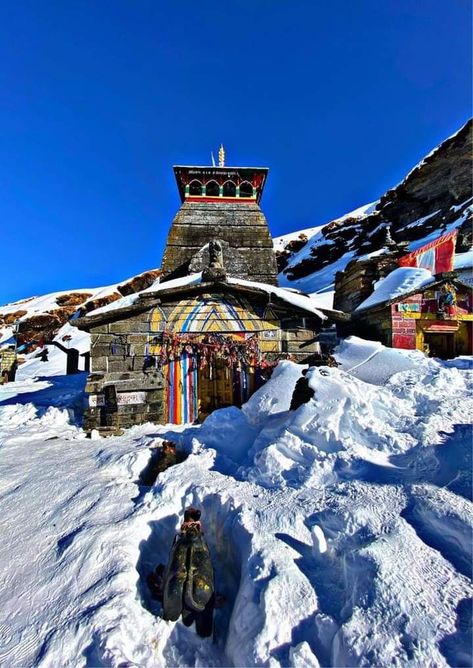Tungnath: A Divine Journey to the Highest Shiva Temple
Introduction
Nestled high in the Himalayas, Tungnath is not just a breathtaking destination but also one of the holiest and most revered places for devotees of Lord Shiva. Located at an altitude of 3,680 meters in the state of Uttarakhand, India, Tungnath is home to the highest Shiva temple in the world. It is a sacred site for both religious pilgrims and nature lovers, offering a unique blend of spirituality, adventure, and unparalleled scenic beauty. In this article, we will explore the biography, history, daily life impacts, and significance of Tungnath, along with its cultural and social importance.
1. The History and Mythology
It is one of the five Kedarnath temples dedicated to Lord Shiva and forms an important part of the Panch Kedar pilgrimage circuit. According to Hindu mythology, the temple was built by Pandavas after the Kurukshetra war as an act of atonement for their sins. The legend says that they sought Lord Shiva’s blessings at this remote location, and in response, Shiva appeared in the form of a lingam at Tungnath. This story highlights Tungnath’s deep connection with the epic Mahabharata and its status as a sacred site of immense historical and spiritual significance.
The temple itself is believed to have been constructed around 1,000 years ago, though its origins are much older, dating back to ancient times when the Pandavas are said to have built the temple to seek divine forgiveness. The region, once shrouded in mystery, has now become one of the most famous pilgrimage sites in the world.
2. Temple: The Spiritual Center
The Temple is a small yet magnificent shrine dedicated to Lord Shiva. The structure is built in traditional North Indian style, with stone carvings that depict various Hindu deities and symbols. The temple’s location amidst the stunning snow-capped peaks of the Garhwal Himalayas makes it a visually captivating site. Its beauty is only heightened by the majestic views of the Chaukhamba, Trishul, and Nanda Devi peaks in the distance, making it one of the most picturesque temples in India.
Devotees visit Tungnath to seek the blessings of Lord Shiva, especially during the auspicious month of Shravan and on Mahashivaratri. The temple also attracts trekkers and nature lovers due to its location, offering a serene escape into the pristine beauty of the Himalayan mountains.
3. Daily Life and Rituals
Due to its remote location, Tungnath Temple has a rather simple but profound spiritual routine. The temple remains open only for a few months during the year, usually from May to November, as it becomes inaccessible due to heavy snowfall in the winter. The temple is opened with great reverence by the local priests, and various rituals are performed daily to honor Lord Shiva.
The priests of the temple conduct aarti during the morning and evening, and devotees offer flowers, milk, and holy offerings. Despite the challenging conditions of the high-altitude environment, devotees undertake the arduous trek to reach the temple, enduring snow, rain, or heat, which adds to the spiritual significance of the journey.
The ritual of pradakshina (circumambulation) around the temple is an essential part of the worship here, symbolizing a devotee’s reverence and connection to the divine. The simple and serene atmosphere of the temple allows for deep spiritual reflection and communion with Lord Shiva.
4. The Tungnath Trek: A Sacred Pilgrimage
For many, the journey to Tungnath is as significant as the destination itself. The trek to the temple is a spiritual journey that requires physical effort, mental resilience, and spiritual dedication. The 3.5-kilometer trail leading to the temple begins from Chopta, a small village in Uttarakhand, and ascends through dense forests, meadows, and rugged terrain.
The trek is challenging, but it offers an experience like no other—each step brings pilgrims closer to the divine while offering spectacular views of the Himalayan landscape. Along the way, trekkers can pause and admire the natural beauty of the region, including the flourishing flora and fauna that thrive at this altitude.
For those seeking an even more adventurous challenge, the trek can be combined with a visit to the nearby Chandrashila peak, which stands at an elevation of 4,000 meters and provides an even more panoramic view of the region.
5. The Significance in Hinduism
Tungnath is part of the Panch Kedar, which is a collection of five temples dedicated to Lord Shiva. The five temples include Kedarnath, Tungnath, Rudranath, Madhyamaheshwar, and Kalimath. The temples are considered highly sacred, and completing the Panch Kedar pilgrimage is believed to purify one’s soul and grant liberation (moksha).
Tungnath holds particular significance because it is the highest Shiva temple in the world, making it a unique site for those wishing to experience a deep connection with the divine. The temple’s isolated location adds to its aura of spiritual power, as it allows devotees to meditate in the peace and serenity of the mountains.
6. The Role in Modern Society
In today’s world, Tungnath Temple continues to play a significant role, not only as a spiritual center but also as a cultural and environmental hub. The local communities around Tungnath, many of whom belong to the Gupta and Brahmin families, play an integral part in the upkeep of the temple and the surrounding environment. These communities are responsible for maintaining the temple rituals, conducting treks, and protecting the local ecosystem.
The eco-tourism aspect of Tungnath also provides economic benefits to the local population while preserving the region’s natural beauty. The pilgrimage to Tungnath fosters a sense of unity and spirituality, attracting visitors from all corners of the world who come to experience the sacred journey and connect with the divine.
7. FAQs About Temple
- Why is Temple so significant?
Tungnath is the highest Shiva temple in the world, and it is an essential part of the Panch Kedar pilgrimage. Its remote location and connection with Hindu mythology make it a deeply spiritual site for devotees. - What is the best time to visit?
The best time to visit Tungnath is between May and November, as the temple remains closed during the winter months due to heavy snowfall. The summer and autumn seasons provide the clearest weather and the most comfortable trekking conditions. - How difficult is the trek?
The trek to Tungnath is moderately difficult. It involves a steady ascent of 3.5 kilometers, with steep inclines and some rough patches, but it is suitable for most pilgrims and trekkers with reasonable fitness levels. - Is there accommodation available near?
Yes, there are basic guesthouses and campsites near Chopta, which is the starting point of the Tungnath trek. However, accommodation is limited, and it’s advisable to book in advance during the peak pilgrimage season. - Can non-Hindus visit the Temple?
Yes, the temple is open to people of all religions. The pilgrimage to Tungnath is a universal spiritual journey, and visitors from different backgrounds are welcome to experience its peaceful and transformative environment.
Conclusion
It stands as a beacon of divine grace and spiritual power, offering not just a physical journey but a soul-enriching experience for those who visit. From its rich history and connection to Hindu mythology to its challenging yet rewarding trek, Tungnath has much to offer to pilgrims, trekkers, and adventurers alike. Whether you come for the divine blessings, the stunning landscapes, or the spiritual solace, a visit to Tungnath promises to leave a lasting impact on your heart and soul.










